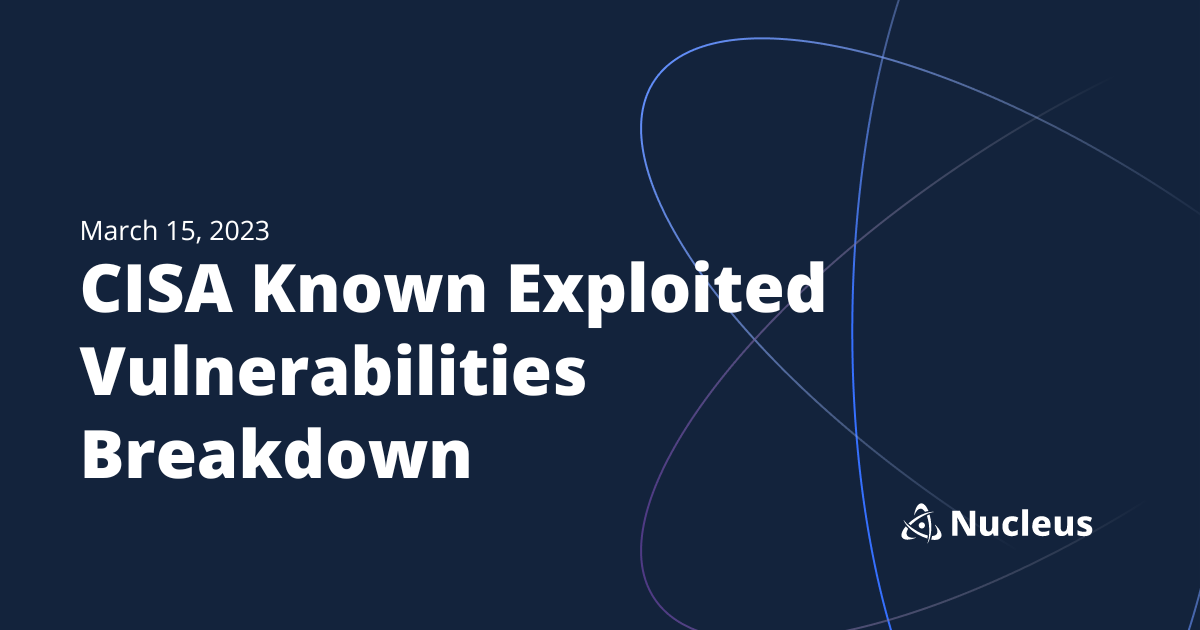March 15, 2023 CISA KEV Breakdown | Adobe

March 15 – 1 New Vuln | CVE-2023-26360
In this CISA KEV Breakdown, one vulnerability, an Adobe ColdFusion improper access control vulnerability, was added to the CISA KEV list.
Notable Vulnerability Additions
CVE-2023-26360 | Adobe ColdFusion Improper Access Control
A vulnerability exists in Adobe ColdFusion 2018 Update 15 and earlier, along with Adobe ColdFusion 2021 Update 5 and earlier, that can allow an attacker to read arbitrary files or potentially execute arbitrary code. Adobe warned of ‘ very limited’ attacks utilizing the three vulnerabilities disclosed in their advisory linked below, that includes CVE-2023-26360. No other details on the activity in-the-wild were given. Exploit code does not appear to be publicly available at time of writing. Users are encouraged to visit the security bulletin posted by Adobe and apply the latest patch.
Adobe also notes the following in their bulletin, “Adobe recommends updating your ColdFusion JDK/JRE to the latest version of the LTS releases for JDK 11. Applying the ColdFusion update without a corresponding JDK update will NOT secure the server. See the relevant Tech Notes for more details.”
Security Advisory:
https://helpx.adobe.com/security/products/coldfusion/apsb23-25.html
← March 14, 2023 CISA Kev Breakdown
Click here to expand our CISA KEV Breakdown Frequently Asked Questions
- What makes for a notable addition?
- A notable addition can arise from many different characteristics. If a particular vulnerability is notable to the security community or a subset of the security community or if the EPSS score reveals notable information about the vulnerability, this can constitute further analysis. It may also be the case that a particular vulnerability shines a light on everyday users and we will highlight important information and key takeaways to ensure users and readers have easy access to actionable information.
- When is the Breakdown released?
- We aim to have our analysis of each KEV update posted within 24 hours of the time in which the Catalog is updated. See CISA’s full catalog here
- I am not bound by BOD 22-01 or federal regulations, why should the KEV concern me?
- CISA encourages all organizations to utilize the Catalog as an attribute in your vulnerability prioritization framework. Organizations looking to lessen the scope on known dangerous vulnerabilities and make a goal to remediate them can understand where they currently stand against what CISA has confirmed as exploited vulnerabilities in the wild. See CISA’s section on “How should organizations use the KEV catalog?” here.
- What is EPSS?
- EPSS is the Exploit Prediction Scoring System. It is an open, data-driven effort for estimating the likelihood (probability) that a software vulnerability will be exploited in the wild. See the EPSS home page on FIRST for more information here.
- What is the difference between EPSS probability and EPSS percent?
- EPSS probability is the risk calculated by the model when determining the perceived threat of the vulnerability itself. Percentage is a relative comparison of the rest of the CVEs within the given sample. While the probability only changes upon refreshing the results from the model, the percentage can change purely based on the CVE sample given. In the case of the Breakdown, we use the percentage given by the pool of all CVEs with given EPSS data. Scores may vary post-release of the post given new information about the vulnerabilities and their perceived threat. For more information on applying and understanding EPSS data, see this article on the FIRST website, as well as their FAQ page.
- What is GreyNoise?
- GreyNoise is a platform that collects, analyzes, and labels data on IPs that scan the internet and saturate security tools with noise. Through their sensor network, GreyNoise observes vulnerability exploitation attempts for vulnerabilities that are exploited in the wild over the Internet. These are arguably vulnerabilities that should be at the very top of your priority list to remediate.
- Why are GreyNoise exploitation attempts only observed on ~20% of KEV vulnerabilities?
- Exploitation of many vulnerabilities in the CISA KEV will not be observed for many reasons that GreyNoise does a good job of explaining in this post. For example:
- The vulnerability may not be remotely exploitable
- Vulnerability exploitation may require authentication (and result in privilege escalation)
- The impacted software may not be exposed to the internet
- Mass scanning/exploitation is not occurring yet
- Exploitation of many vulnerabilities in the CISA KEV will not be observed for many reasons that GreyNoise does a good job of explaining in this post. For example:
See Nucleus in Action
Discover how unified, risk-based automation can transform your vulnerability management.






























